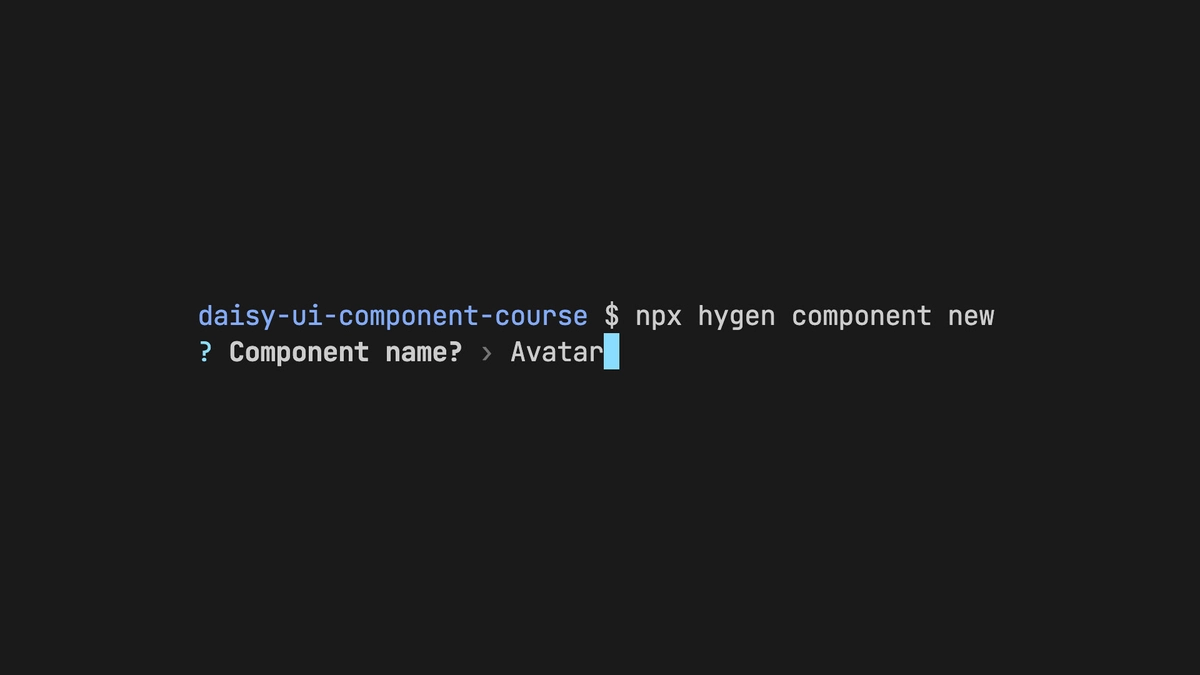Use Hygen to Bootstrap New Components in your Custom Vue UI Library
Hygen is a code generator that saves you time, keeps your file structure consistent, and ensures you don’t forget important steps when creating a new component in a custom component library. Let’s see how it works.
What is Hygen
At it’s core, it’s just a way of copying code from templates to real application files. All templates are stored in a folder called _templates at the root of your project.
A file structure like this would support the command npx hygen component new
_templates
component
new
component.vue.t
docs.md.t
...Creating New Files
To create new files you would create a template that has front matter and a template body. The to property determines where the newly created file will be stored.
// _templates/component/new/component.vue.t
---
to: packages/library/src/components/<%= name %>/<%= name %>.vue
---
<script setup lang="ts">
</script>
<template>
<div>
Hello <%= name %>
</div>
</template>You support dynamic placeholders with EJS syntax in both the frontmatter and the template body.
<%= name %>You can support as many variables as you’d like by defining prompts in a prompt.js within the same directory.
// _templates/component/new/prompt.js
// see types of prompts:
// https://github.com/enquirer/enquirer/tree/master/examples
//
// eslint-disable-next-line
module.exports = [
{
type: 'input',
name: 'name',
message: 'Component name?'
}
]
When running the command the user will be prompted and the variable will be replaced in the template with the user provided value.

The generated file would look like this:
// packages/library/src/components/Accordion/Accordion.vue
<script setup lang="ts">
</script>
<template>
<div>
Hello Accordion
</div>
</template>Use Cases for Creating New Files
This can be used for all kinds of things. When running npx hygen component new you could bootstrap not only component files but also:
Injecting Lines into Existing Files
It’s also common for UI libraries to expose component .vue source files for importing into end developer’s projects. This makes the library tree-shakeable and works great for projects that use a build tool like Vite.
import Accordian from './Accordian/Accordian.vue'
import AccordianPanel from './AccordianPanel/AccordianPanel.vue'
import Badge from './Badge/Badge.vue'
import Button from './Button/Button.vue'
// etc...
export {
Accordian,
AccordianPanel,
Badge,
Button,
}Easily inject new components into this file. How?
First, add comments in the file where you want to inject the new lines like this:
import Accordian from './Accordian/Accordian.vue'
//...
// import - do not remove this line, used for hygen generations
export {
Accordian,
AccordianPanel,
Badge,
Button,
// export - do not remove this line, used for hygen generations
}Then create a couple more hygen templates, this time with the inject option in the frontmatter.
// _templates/component/new/comp-import.ts.t
---
inject: true
to: packages/library/src/components/components.ts
before: "// import - do not remove this line, used for hygen generations"
skip_if: "import <%= name %> from './<%= name %>/<%= name) %>.vue'"
---
import <%= name %> from './<%= name %>/<%= name %>.vue'// _templates/component/new/comp-export.ts.t
---
inject: true
to: packages/library/src/components/components.ts
before: "// export - do not remove this line, used for hygen generations"
---
<%= name %>,Use Cases for Injecting New Lines into Existing Files
Not only is injection great for exporting all your library components from a single file but it’s also good for adding a link to your new component in your documentation.
Conclusion
Hygen is a handy tool for use in any Vue.js project but it’s especially useful for bootstrapping new components in a custom component library. Learn more about using Hygen to build a custom component library plus a whole lot more in our course: Crafting a Custom Component Library with Vue and Daisy UI.
Article originally posted on Vue School by Daniel Kelly.



